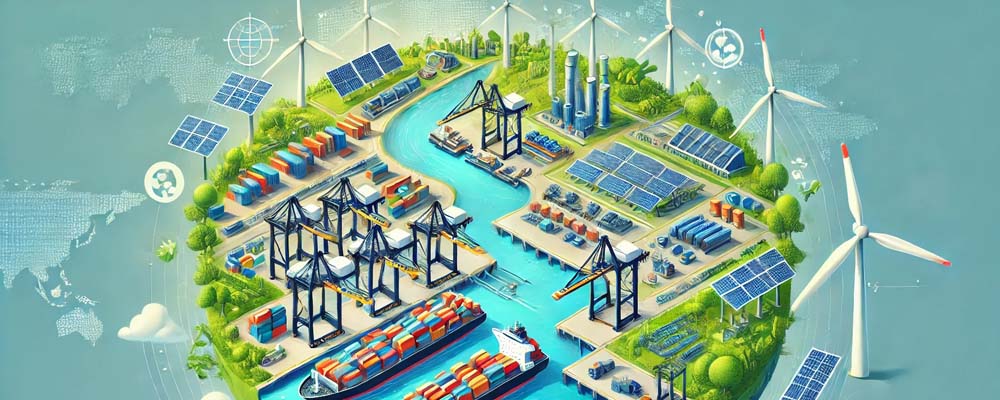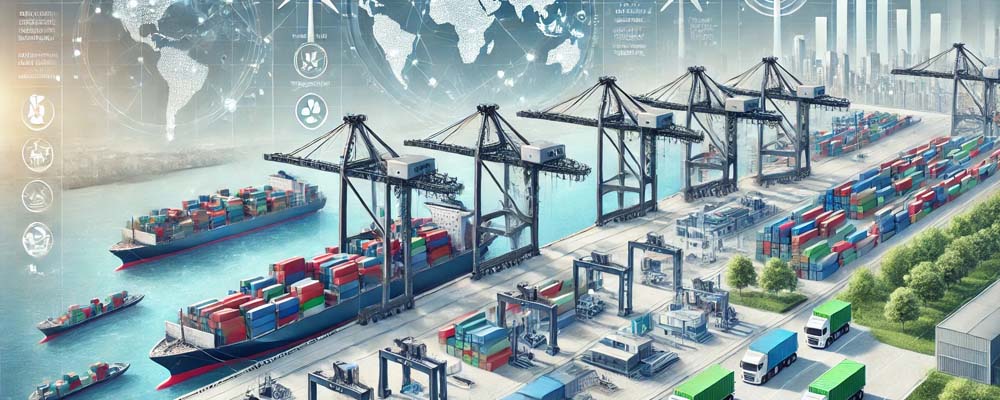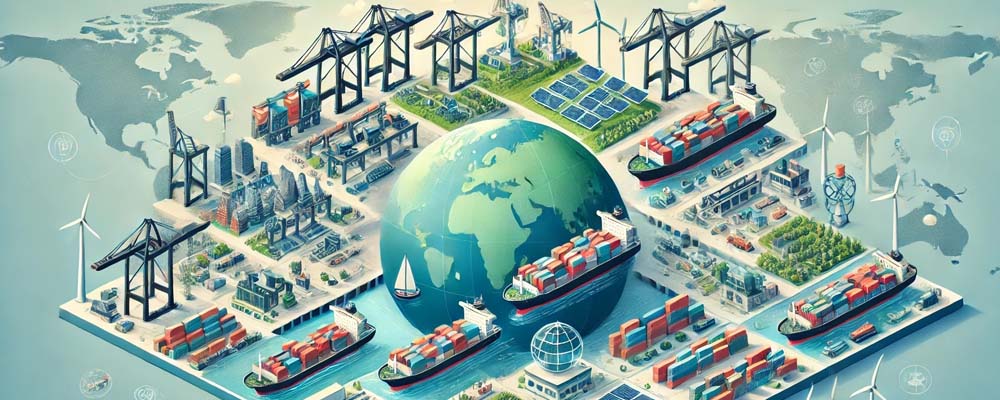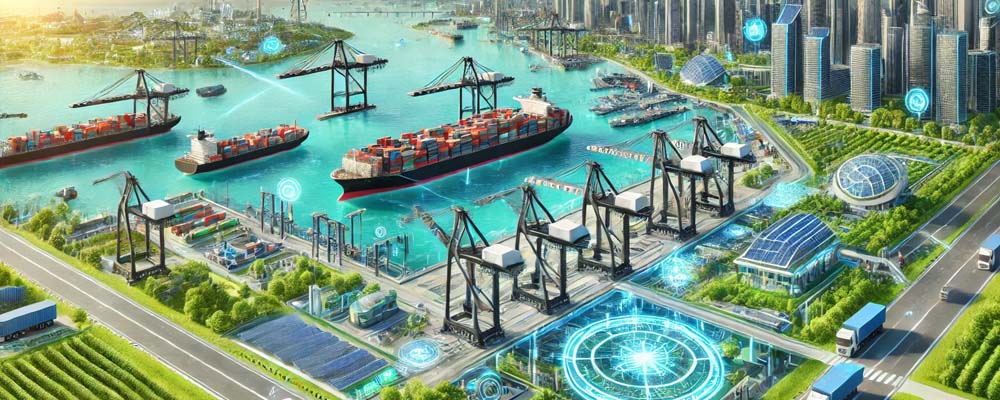
As the world becomes more interconnected, global trade and logistics systems are essential to economic growth. Ports are central to this system, handling more than 80% of the world’s goods by volume. But as environmental concerns mount, these critical hubs are also being scrutinized for their environmental impact. Major global ports are increasingly adopting sustainable practices to reduce emissions, minimize waste, and promote efficient, eco-friendly logistics.
This article delves into the pivotal role major global ports play in sustainable logistics and highlights how their initiatives contribute to a greener, more efficient supply chain. We will explore the emerging trends, best practices, and challenges that global ports face as they transition toward sustainability.
1. The Environmental Impact of Ports in Global Trade
The Carbon Footprint of Ports
Ports are large-scale industrial hubs, responsible for significant amounts of emissions and energy consumption. The environmental challenges posed by ports include:
- Air Pollution: Ports generate considerable air pollution due to the high volumes of ship emissions, cargo-handling equipment, and transportation vehicles. Cargo ships primarily use heavy fuel oil, which releases sulfur oxides (SOx), nitrogen oxides (NOx), and particulate matter (PM) into the atmosphere.
- Water Pollution: Wastewater discharge, ballast water, and accidental oil spills are major concerns. Port operations can contaminate local water bodies, disrupting marine ecosystems.
- Energy Consumption: Ports are energy-intensive, with extensive lighting, refrigerated storage facilities, and cranes consuming massive amounts of electricity.
Contribution to Global Supply Chain Emissions
With the increasing pressure on global supply chains to operate sustainably, ports must play a key role in reducing the carbon footprint of international trade. As supply chains become more complex, with the rise of e-commerce, fast-paced logistics, and Just-In-Time (JIT) delivery models, ports are adapting their operations to balance efficiency and environmental responsibility.
 2. Trends in Sustainable Logistics at Major Ports
2. Trends in Sustainable Logistics at Major Ports
Green Port Initiatives
Many major global ports are now part of international initiatives to create more sustainable logistics networks. These initiatives aim to reduce emissions, improve efficiency, and create a circular economy within port operations. Some noteworthy programs include:
- World Ports Climate Initiative (WPCI): Launched by the International Association of Ports and Harbors (IAPH), this initiative seeks to promote low-carbon port development. It has led to the implementation of shore power facilities, vessel speed reduction programs, and cleaner fuels.
- The Green Marine Program: This environmental certification program is tailored to the marine industry, allowing ports and shipping companies to improve environmental performance based on self-assessment and external verification.
- EcoPorts Initiative: Led by the European Sea Ports Organization (ESPO), this program encourages ports to measure their environmental footprint and implement strategies to reduce their negative impact.
Shore Power and Electrification of Port Equipment
One of the most significant innovations in sustainable port logistics is the adoption of shore power. Also known as cold ironing, shore power allows vessels to plug into the local electrical grid while docked, rather than relying on their onboard diesel engines. This drastically reduces the emissions of pollutants and greenhouse gases (GHGs) in port cities.
In addition to shore power, ports are electrifying their cargo-handling equipment, such as cranes, trucks, and forklifts. Replacing diesel-powered equipment with electric alternatives not only reduces emissions but also cuts down on noise pollution, which is a concern for communities near ports.
Sustainable Dredging Practices
Dredging is an essential activity for maintaining the depth of harbors, but it can be highly disruptive to marine ecosystems. To address this, ports are adopting sustainable dredging practices that minimize environmental impact. Techniques such as sediment relocation, silt curtains, and the use of environmentally friendly dredgers help reduce the ecological footprint of these activities.
LNG and Alternative Fuels
The shipping industry is undergoing a transformation toward the use of alternative fuels. Liquefied Natural Gas (LNG) has emerged as a cleaner alternative to conventional heavy fuel oil, with fewer sulfur emissions and lower carbon content. Some ports, like Rotterdam and Singapore, have developed dedicated LNG bunkering facilities to support this transition.
Other alternative fuels being explored include biofuels, hydrogen, and ammonia. Ports are investing in research and infrastructure to accommodate these future fuels, recognizing their importance in achieving long-term sustainability goals.
 3. Case Studies: Leading Global Ports in Sustainable Logistics
3. Case Studies: Leading Global Ports in Sustainable Logistics
Port of Rotterdam
As Europe’s largest port, the Port of Rotterdam has made sustainability a core part of its development strategy. It aims to become the most sustainable port in the world through several key initiatives:
- Rotterdam Energy Port: The port has become a hub for renewable energy projects, including wind, solar, and biomass energy production.
- Carbon Capture and Storage (CCS): The port is developing a large-scale CCS project, which will capture CO2 emissions from industrial facilities and store them under the North Sea.
- Circular Economy: The port is investing in circular economy models where waste materials are repurposed into new resources, helping industries reduce their reliance on raw materials and limit waste production.
Port of Los Angeles
The Port of Los Angeles is the busiest port in the United States and has long been at the forefront of environmental initiatives. Its Clean Air Action Plan (CAAP), established in 2006, aims to drastically reduce port-related emissions. Key measures include:
- Zero Emissions Goal: The port has committed to transitioning all cargo-handling equipment to zero emissions by 2030 and all on-road trucks by 2035.
- On-Dock Rail: Expanding the port’s rail network reduces the reliance on trucks, thus lowering emissions and improving cargo handling efficiency.
- Energy-Efficient Buildings: The port has invested in LEED-certified buildings, energy-efficient lighting, and solar power installations to minimize its carbon footprint.
Port of Singapore
Singapore, one of the world’s busiest ports, is also a leader in green logistics. The Maritime Singapore Green Initiative promotes sustainable shipping practices through the following programs:
- Green Ship Program: This incentivizes shipping companies to adopt cleaner vessel designs that exceed the International Maritime Organization (IMO) standards.
- Green Port Program: Singapore offers fee reductions for vessels that use low-sulfur fuel or shore power while in port.
- Sustainable Port Development: Singapore is expanding its port infrastructure with sustainability in mind, including the use of automated, energy-efficient cranes and smart logistics systems to optimize cargo flow.
4. Challenges in Achieving Sustainable Ports
High Costs of Implementation
While the benefits of sustainable logistics are clear, the transition comes with significant costs. Investing in electrification, alternative fuels, and infrastructure upgrades requires considerable financial resources, which may be a barrier for smaller ports or those in developing regions.
Regulatory Hurdles
Regulations governing port emissions and environmental performance vary widely by region. Navigating these complex regulatory landscapes can be challenging, especially for ports that handle international traffic. Aligning global regulations with local environmental policies is critical to ensuring ports can continue to operate efficiently while meeting sustainability goals.
Technological Limitations
Although technologies like shore power, electrification, and alternative fuels offer promise, they are not yet fully mature. Research and development are needed to improve the scalability, affordability, and effectiveness of these solutions. Additionally, the infrastructure needed to support alternative fuels like hydrogen and ammonia is still in the early stages of development, limiting their widespread adoption.
Balancing Economic Growth and Sustainability
Ports are vital to global trade and economic growth, and any slowdown in their operations can have a ripple effect across the supply chain. Balancing economic performance with sustainability efforts is a complex task. Ports need to ensure that sustainability initiatives do not compromise their ability to handle high volumes of cargo efficiently.
 5. The Future of Sustainable Ports and Logistics
5. The Future of Sustainable Ports and Logistics
The future of sustainable ports hinges on continued innovation and collaboration among industry stakeholders. Emerging trends highlight the use of digital technologies like smart logistics platforms, blockchain, and data analytics to optimize operations, reduce waste, and lower emissions.
Furthermore, port communities are expected to play a more active role in driving sustainability. Ports will increasingly engage with local stakeholders, including residents, environmental organizations, and governments, to ensure that their development aligns with broader sustainability goals.
International Collaboration
Global trade depends on international cooperation, and the path toward sustainable ports requires collaborative efforts among countries, shipping companies, and ports. International agreements such as the IMO’s regulations on GHG emissions from ships and the Paris Agreement provide a framework for reducing the environmental impact of maritime transport. However, success will require coordinated action, especially in sharing best practices and technological innovations across borders.
Conclusion
Major global ports are key to the future of sustainable logistics. By adopting green technologies and efficient practices, they reduce their environmental impact while supporting global trade. However, challenges like high costs, regulations, and innovation gaps remain. As ports continue to evolve, their leadership in sustainability will foster a cleaner environment and provide a competitive edge. For logistics providers, manufacturers, and e-commerce businesses, partnering with sustainable ports offers benefits like cost savings, improved efficiency, and a stronger eco-friendly reputation. Sustainable logistics is not just a trend—it’s the future of global trade.




 2. Trends in Sustainable Logistics at Major Ports
2. Trends in Sustainable Logistics at Major Ports 3. Case Studies: Leading Global Ports in Sustainable Logistics
3. Case Studies: Leading Global Ports in Sustainable Logistics 5. The Future of Sustainable Ports and Logistics
5. The Future of Sustainable Ports and Logistics



